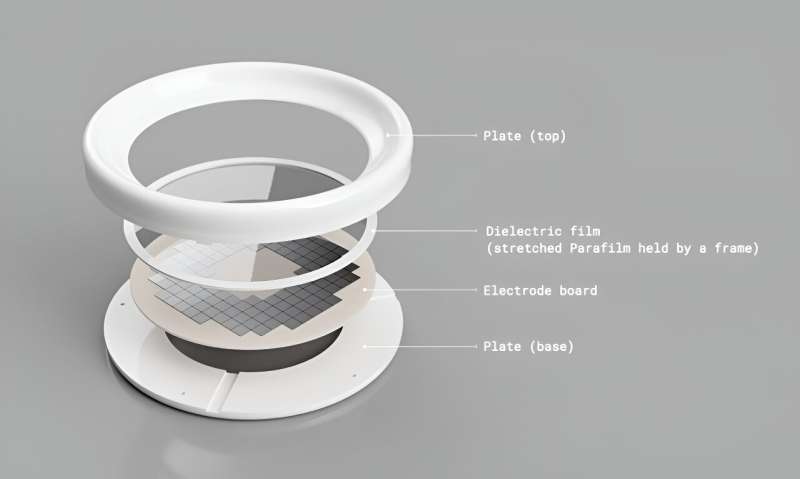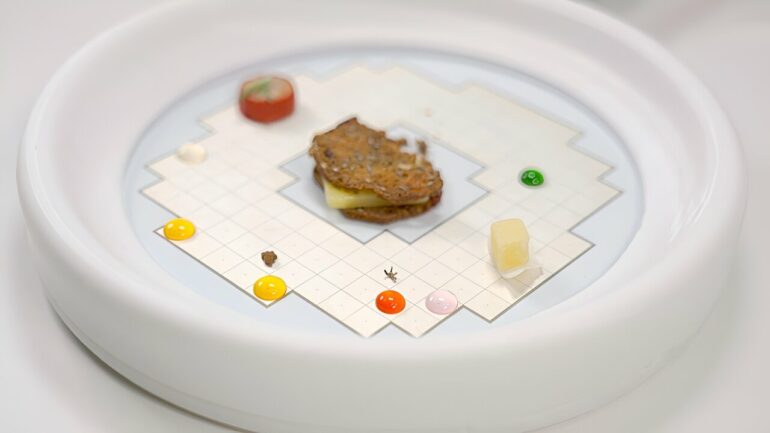A new Monash University project programs food to “dance” across platters, providing playful and interactive culinary opportunities for diners and chefs.
The research paper, published in the Proceedings of the 2023 ACM Designing Interactive Systems Conference, explores the design of food as a material through which computer programs can be enacted.
Food interaction design researcher and lead author of the research Jialin Deng, from Monash University’s Faculty of Information Technology (IT), designed a system encompassing a plate fitted with electrodes that can be programmed to move different food elements like sauces and condiments around on their own, creating new combinations or elements for the diner in a playful manner.
Deng said the project was about exploring the integration of food’s material properties and “computational” capabilities. The aim was to achieve different dining journeys.
“For example, a chef can predefine the locations where they want to put the food droplets and ingredients, and they can program the dish frame by frame, like you do in animation,” Deng said.
“We can put solid items and watery items together, we can merge two different flavors, we can transport various things towards the plate, we can play with chemical or physical reactions like in molecular gastronomy.”
Interaction, game and play design expert from the Faculty of IT’s Creative Technologies discipline group and co-author of the research, Professor Florian “Floyd” Mueller, says the research is a glimpse into the future of food and computing.

We designed a new plate that embeds “electrowetting on dielectric” technology in order to be able to execute precise motion operations of aqueous droplets. This technology utilizes electrical voltage to unbalance the force equilibrium at the solid-liquid-vapor interface, causing the droplets to move toward the charged electrodes. © Monash University
“The integration of food and computing will transform how we understand both computing and food as not two very different things, but a new frontier that combines the best of both,” Mueller said.
“This will not only change the hospitality industry, who can create much more engaging experiences by being able to tell new and different stories through interactive food, but also computer science education, where students learn about computing by eating food.”
The researchers conducted co-design workshops with chefs to give them a chance to experiment with the system by crafting real dishes to create new culinary combinations. The dishes were presented in multiple subsequent dining experience events.
Monash Club Head Chef and one of the workshop participants, Mr. Matthew Birley, said combining technology with food presents a great new path for chefs in terms of culinary experimentation.
“The project helped to unlock additional dimensions to creating dishes while thinking more keenly about the diner’s interaction with the food,” Birley said.
“We really start to interact with the feelings and movements of the diner. I think this can have a great impact on what we can do as chefs in the dining industry.”
To learn more about the dancing delicacies project, visit: https://exertiongameslab.org/dancing-delicacies-interactive-food.
More information:
Jialin Deng et al, Dancing Delicacies: Designing Computational Food for Dynamic Dining Trajectories, Proceedings of the 2023 ACM Designing Interactive Systems Conference (2023). DOI: 10.1145/3563657.3596021
Citation:
Dancing delicacies: Combining food and tech for interactive dining (2023, October 6)



